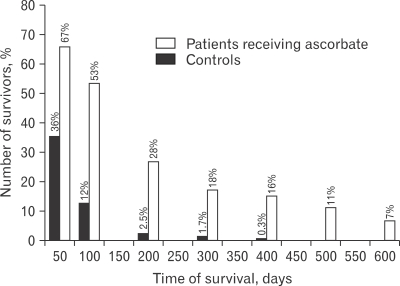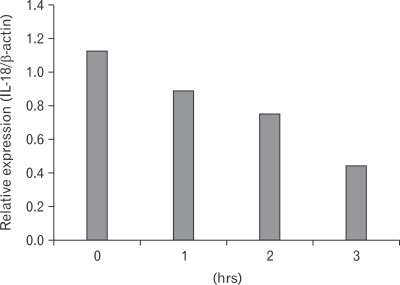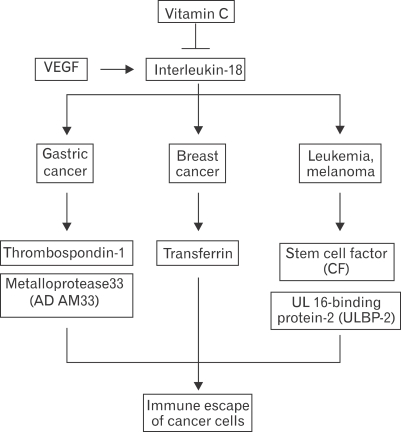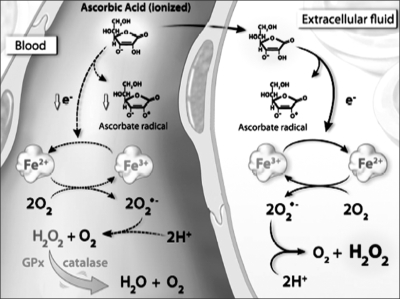Abstract
Ascorbate (vitamin C) is a cofactor for a number of metabolic enzymes and is an indisputable essential vitamin C for humans. However, the potential of ascorbate as an anticancer agent has been a topic of controversy. A number of previous reports have addressed both positive aspects and limitations of ascorbate in cancer therapy. In this review, we briefly summarize the potential antitumor effects of ascorbate and its prospects for clinical use.
Keywords: ascorbate, ascorbic acid, vitamin C, cancer, intravenous, cytotoxicity, antioxidant, prooxidant, chemotherapy, tumor growth
INTRODUCTION
The role of ascorbate (vitamin C) in cancer treatment is a subject with a controversial history (1,2). The core of this controversy is the lack of reproducibility of the therapeutic effects of ascorbate on cancer patients (3), a problem compounded by uncertainties associated with deficiencies of independent pathologic confirmation and failure to include appropriate placebo groups in clinical studies (4-7). However, more recent studies on the therapeutic effects of ascorbate have provided a clearer understanding of its effect in cancer treatment. The action of ascorbate in cancer cells has also been more clearly defined by in vitro studies. In this review, we summarize these new findings and discuss the biological mechanism of action of ascorbate in cancer therapy.
HISTORY OF CANCER TREATMENT
Several decades ago, McCormick, Cameron and Rotman, without supporting data, postulated two hypotheses regarding the use of ascorbate for cancer therapy (8-10). One hypothesis was that ascorbate exerts an antitumor effect by increasing collagen synthesis (8,9). The other proposed that the anticancer effects of ascorbate were due to inhibition of hyaluronidase, which decomposes hyaluronic acid (10). Pauling, Cameron and Leibovitz provided a scientific basis to support these hypotheses, which they subsequently popularized (11,12).
On the basis of an initial study of the antitumor effects of ascorbate in 50 patients with advanced cancer, Cameron and colleagues concluded that high-dose ascorbate improved treatment outcome (12). Cameron and Pauling subsequently published the results of another clinical study in 1978 (3,13), showing that the long-term survival of cancer patients who received high-dose ascorbate supplements was 20 times greater than that of patient in the control group (Fig. 1) (14). In addition, a prospective study published in 1991 showed that survival of ascorbate-treated patients was 343 days compared to 180 days for controls who did not receive ascorbate (15). However, Moertel and Mayo concluded that there was no significant difference in survival between ascorbate-treated and -untreated groups (5,6). The discrepancy between the findings of these studies may reflect differences in the route of ascorbate administration: Cameron administered ascorbate both orally and intravenously, whereas Moertel administered ascorbate exclusively through the oral route. These findings are summarized in Fig. 2 (16-18). In addition, the Mayo study was criticized because a majority of the enrolled patients had received prior chemotherapy, unlike the Cameron study, in which a minority of patients (4/100) had been previously treated with radiation and chemotherapy (14). Although the efficacy of ascorbate against cancer should be reassessed, tantalizing results from clinical studies argue that ascorbate may be a potential anticancer agent. The detailed analyses of ascorbate actions in cancer cells were predicated on this possibility.
Figure 1.
A comparison of survival times in patients supplemented with or without ascorbate. adapted from cameron and pauling (18).
Figure 2.
Effect of ascorbate on IL-18 production. Adapted from Lee WJ (39). B16F10 melanomas cells (2×105 cells/ml) were cultured in media with 0.2 mM ascorbate.
BIOLOGICAL ROLE
One biochemical function of ascorbate is to enhance hydroxylation in a large number of biosynthetic reactions (19,20). In a majority of these biosynthetic processes, ascorbate provides necessary electrons to participating enzymes and is required to achieve full enzymatic activity (19). The characteristic role of ascorbate is as a cofactor for prolyl and lysyl hydroxylase enzymes (20). Ascorbate is also necessary for cholesterol metabolism, cytochrome p450 activity (21), neurotransmitter synthesis (20) and the synthesis of carnitine from lysine (22,23). Importantly, ascorbate has dual properties in oxidative processes, acting as both an antioxidant and a prooxidant.
Ascorbate is considered to be an important antioxidant in extracellular fluid (24); it also guards against aqueous radicals in blood (25) and protects plasma lipids from peroxidative damage caused by peroxyl radicals (26). Thus, in this capacity, ascorbate protects a number of cells and tissues throughout the body from oxidative stress. Conversely, ascorbate also accelerates oxidative metabolism by preventing the use of pyruvate for glycolysis (27). This property helps to inhibit the proliferation of tumor cells, but not normal cells (28-30). In a great number of malignant cancer cell lines, it is quite interesting that the cytotoxic effect of ascorbate is correlated with its prooxidant activity (31-35).
VITAMIN C IN CANCER TREATMENT
Vitamin C as an immune-modulator
Ascorbate enhances resistance against pathogens by stimulating the immune system (36-38). Recently, we reported that ascorbate suppresses production of IL-18, a key regulator in malignant skin tumors, including melanomas and squamous cells carcinomas (Fig. 3) (39). IL-18 is known as an interferon-γ-inducing factor, and is capable of stimulating interferon-γ production by natural killer (NK) cells, activated macrophage, and T cells (40). Importantly, it has been recently reported that IL-18 expression is positively correlated with various tumors (41).
Figure 3.
A model inhibiting IL-18 networks by ascorbate. Ascorbate inhibits IL-18-induced the immune escape of various cancer cells, including gastric, breast, leukemia, and melanomas.
In gastric cancer cells, IL-18 production is enhanced by vascular endothelial growth factor (VEGF), resulting in increased IL-18-mediated tumor cell migration (42). In breast cancer cells, IL-18 induces the expression of transferrin (43), which is a positive regulator of cell growth and proliferation (44). Thus, one mechanism by which ascorbate may be effective against cancer is through down-regulation of IL-18, which plays an important role in controlling the escape of various cancer cells, including melanimas, gastric, and breast cancer cells, from immune surveillance (Fig. 4).
Figure 4.
A mechanism of preferential formation of ascorbate radicals (Asc-) and H2O2 in extracellular fluid compared with blood. Adapted from Levine (60).
Importantly, dosage is a key to the effectiveness of ascorbate as an immune-modulator. On the basis of the above reports, we recently postulated that a dose of ascorbate, 100~250 µM may help prevent the immune escape of cancer cells. These dosages can be achieved by daily oral supplements of ascorbate.
Alternative properties of vitamin C as an antioxidant and prooxidant
Ascorbate is the reduced form of vitamin C, which also exists physiologically in the oxidized form, dehydroascorbic acid (DHA). DHA is taken up into cells by glucose transporters (45,46). Inside the cell, it is reduced to ascorbic acid (45,46) and decreases intracellular ROS levels, thus acting initially as an antioxidant (47-49). In a recent study, Conner and colleagues reported that all antineoplastic drugs tested produced mitochondrial dysfunction, including loss of mitochondrial membrane potential and an increase in ROS levels, and showed that this phenomenon was inhibited by vitamin C. They postulated that vitamin C acts as an antioxidant to protect cells against mitochondrial dysfunction induced by antineoplastic agents, and thus antagonizes the cytotoxic effects of antineoplastic drugs (50). In a similar vein, Blair cautioned that because vitamin C/d (200 mg) induced decomposition of lipid hydroperoxides to endogenous genotoxins, it might be counterproductive in cancer treatment (51,52). This study was also unable to find support for the notion that vitamin C induced lipid peroxidation (53).
However, the emphasis of these studies in the potential antioxidant properties of vitamin C overlooks the capacity of ascorbate to act as a prooxidant. In our previous studies, we have shown that ascorbate induces apoptosis in B16F10 murine melanomas through mitochondrial dysfunction (54). A high dose of ascorbate induced a decrease in mitochondrial membrane potential and a release of cytochrome c from mitochondria to cytosol, which acted to promote apoptosis. A low dose of ascorbate induced cell-cycle arrest of cancer cells (55,56). Thus, the effect of ascorbate on cancer cells was mediated by an increase in intracellular ROS levels. In addition, we showed that ascorbate, acting as a prooxidant, inhibited cancer cell growth through other mechanisms, including induction of endoplasmic reticulum stress, suppression of insulin-like growth factor production, and inhibition of angiogenic factor production (our unpublished data, 57,58). Levine and colleagues have also reported anticancer activities of ascorbate that were attributable to its prooxidant properties, showing that ascorbate acts as a prooxidant and decreases tumor growth in mice (59). They also showed that ascorbate produced hydrogen peroxide-dependent cytotoxicity in various cancer cells without affecting normal cells. More importantly, Levine suggested that ascorbate-induced formation of hydrogen peroxide preferentially occurs in extracellular fluid compared with blood (Fig. 5) (60). These studies provide a mechanistic basis for applying ascorbate as a prooxidant therapeutic agent for cancer treatment.
Figure 5.
Clinical studies of ascorbate and cancer survival (17).
Although ascorbate has shown inhibitory effects in a variety of cancer cells, including melanomas, brain tumor, prostate cancer, and stomach cancer cell, the relative chemosensitivity of different cancer cells to ascorbate varies. This potential drawback in an otherwise positive profile has not yet been fully addressed, despite a number of studies that have attempted to explain the mechanism-of-action of ascorbate in cancer cells. Prior to application of ascorbate in cancer therapy, it will be necessary to fully elucidated the detailed mechanisms by which ascorbate inhibits cancer cell proliferation.
CLINICAL TRIALS
Masaki Inoue suggested in his review that application of US National Cancer Institute (NCI) Best-Case Series guidelines (http://www.cancer.gov/cam/bestcase_intro.html) is one way to advance the clinical possibility of ascorbate for the cancer therapy (16,61,62). These guidelines comprise several standards. First, there must be a plausible diagnosis of cancer based on a clinic examination, preferably including a tissue biopsy. Second, the patient should not be treated concurrently with ascorbate and other therapeutic modalities, including radiation and chemotherapy. Third, the treatment history of patient should be known. One such study of three carcinoma cases documented by Padayatty and conducted in accordance with NCI Best-Case Series guidelines (16,63) showed that cancer progression was significantly suppressed by high-dose intravenous vitamin C therapy. More such clinical studies, in conjunction with additional basic research, are needed to buttress the scientific support for the clinical plausibility of using vitamin C in the treatment of cancer.
CONCLUSION
Several lines of evidence support the notion that ascorbate improves the well-being and survival of cancer patients, especially when administered intravenously. The beneficial effects of ascorbate in cancer treatment reflect the ability of ascorbate to inhibit cancer cell proliferation. We also suggest that oral administration of ascorbate can inhibit the immune escape of cancer cells through suppression of IL-18 expression. Importantly, ascorbate is not cytotoxic towards normal cells; thus, ascorbate may be a model antineoplastic agent, prolongling survival and improving the quality of life through selective inhibition of tumor growth.
Based on the collective evidence, we propose that acorbate, especially intravenous ascorbate, would be a helpful medicine in cancer therapy, and we encourage more in vitro preclinical studies to determine its detailed mechanisms-of-action in cancer cells.
Footnotes
The authors have no financial conflict of interest.
References
- 1.Cameron E, Pauling L, Leibovitz B. Ascorbic acid and cancer: a review. Cancer Res. 1979;39:663–681. [PubMed] [Google Scholar]
- 2.Golde DW. Vitamin C in cancer. Integr Cancer Ther. 2003;2:158–159. doi: 10.1177/1534735403002002009. [DOI] [PubMed] [Google Scholar]
- 3.Cameron E, Pauling L. Supplemental ascorbate in the supportive treatment of cancer: reevaluation of prolongation of survival times in terminal human cancer. Proc Natl Acad Sci U S A. 1978;75:4538–4542. doi: 10.1073/pnas.75.9.4538. [DOI] [PMC free article] [PubMed] [Google Scholar]
- 4.Padayatty SJ, Levine M. Reevaluation of ascorbate in cancer treatment: emerqing evidence, open minds and serendipity. J Am Coll Nutr. 2000;19:423–425. doi: 10.1080/07315724.2000.10718941. [DOI] [PubMed] [Google Scholar]
- 5.Creagan ET, Moertel CG, O'Fallon JR, Schutt AJ, O'Connell MJ, Rubin J, Frytak S. Failure of high-dose vitamin C (ascorbic acid) therapy to benefit patients with advanced cancer. A controlled trial. N Engl J Med. 1979;301:687–690. doi: 10.1056/NEJM197909273011303. [DOI] [PubMed] [Google Scholar]
- 6.Moertel CG, Fleming TR, Creagan ET, Rubin J, O'Connell MJ, Ames MM. High-dose vitamin C versus placebo in the treatment of patients with advanced cancer who have had no prior chemotherapy. A randomized double-blind comparison. N Engl J Med. 1985;312:137–141. doi: 10.1056/NEJM198501173120301. [DOI] [PubMed] [Google Scholar]
- 7.Wittes RE. Vitamin C and cancer. N Engl J Med. 1985;312:178–179. doi: 10.1056/NEJM198501173120310. [DOI] [PubMed] [Google Scholar]
- 8.McCormick WJ. Cancer: the preconditioning factor in pathogenesis; a new etiologic approach. Arch Pediatr. 1954;71:313–322. [PubMed] [Google Scholar]
- 9.McCormick WJ. Cancer: a collagen disease, secondary to a nutritional deficiency. Arch Pediatr. 1959;76:166–171. [PubMed] [Google Scholar]
- 10.Cameron E, Rotman D. Ascorbic acid, cell proliferation, and cancer. Lancet. 1972;1:542. doi: 10.1016/s0140-6736(72)90215-2. [DOI] [PubMed] [Google Scholar]
- 11.Cameron E, Pauling L. Ascorbic acid and the glycosaminoglycans. An orthomolecular approach to cancer and other diseases. Oncology. 1973;27:181–192. doi: 10.1159/000224733. [DOI] [PubMed] [Google Scholar]
- 12.Cameron E, Campbell A. The orthomolecular treatment of cancer, II: clinical trial of high-dose ascorbic acid supplements in advanced human cancer. Chem Biol Interact. 1974;9:285–315. doi: 10.1016/0009-2797(74)90019-2. [DOI] [PubMed] [Google Scholar]
- 13.Cameron E, Pauling L. Supplemental ascorbate in the supportive treatment of cancer: prolongation of survival times in terminal human cancer. Proc Natl Acad Sci U S A. 1976;73:3685–3689. doi: 10.1073/pnas.73.10.3685. [DOI] [PMC free article] [PubMed] [Google Scholar]
- 14.Head KA. Ascobic acid in the prevention and treatment of cancer. Altern Med Rev. 1998;3:174–186. [PubMed] [Google Scholar]
- 15.Cameron E, Campbell A. Innovation vs. quality control: an 'unpublishable' clinical trial of supplemental ascorbate in incurable cancer. Med Hypotheses. 1991;36:185–189. doi: 10.1016/0306-9877(91)90127-k. [DOI] [PubMed] [Google Scholar]
- 16.Graumlich JF, Ludden TM, Conry-Cantilena C, Cantilena LR, Jr, Wang Y, Levine M. Pharmacokinetics model of ascorbic acid in healthy male volunteers during depletion and repletion. Pharm Res. 1997;14:1133–1139. doi: 10.1023/a:1012186203165. [DOI] [PubMed] [Google Scholar]
- 17.Satoshi O, Yumiko O, Nobutaka S, Gen-Ichiro S, Masaki I. High-dose vitamin C (Ascorbic acid) therapy in the treatment of patient with advanced cancer. Anticancer Res. 2009;29:809–816. [PubMed] [Google Scholar]
- 18.Keith I, Block MD, Mark N, Mead MS. Vitamin C in alternative cancer treatment: Historical background. Integrative Cancer Therapies. 2003;2:147–154. doi: 10.1177/1534735403002002007. [DOI] [PubMed] [Google Scholar]
- 19.González MJ, Miranda-Massari JR, Mora EM, Guzmán A, Riordan NH, Riordan HD, Casciari JJ, Jackson JA, Ráman-Franco A. Orthomolecular oncology review: ascorbic acid and cancer 25 years later. Interg cancer therapies. 2005;4:32–44. doi: 10.1177/1534735404273861. [DOI] [PubMed] [Google Scholar]
- 20.Levine M. New concepts in the biology and biochemistry of ascorbic acid. N Engl J Med. 1986;314:892–902. doi: 10.1056/NEJM198604033141407. [DOI] [PubMed] [Google Scholar]
- 21.Block G. Vitamin C and cancer prevention: the epidemiologic evidence. Am J Clin Nutr. 1991;53:s270–s282. doi: 10.1093/ajcn/53.1.270S. [DOI] [PubMed] [Google Scholar]
- 22.Rebouche CJ. Ascorbic acid and carnitine biosynthesis. Am J Clin Nutr. 1991;54:s1147–s1152. doi: 10.1093/ajcn/54.6.1147s. [DOI] [PubMed] [Google Scholar]
- 23.Englard S, Seifter S. The biochemical functions of ascorbic acid. Annu Rev Nutr. 1986;6:365–406. doi: 10.1146/annurev.nu.06.070186.002053. [DOI] [PubMed] [Google Scholar]
- 24.Sies H, Stahl W, Sundquist AR. Antioxidant functions of vitamins. Vitamins E and C, beta-carotene and other carotenioids. Ann N Y Acad Sci. 1992;669:7–20. doi: 10.1111/j.1749-6632.1992.tb17085.x. [DOI] [PubMed] [Google Scholar]
- 25.Niki E. Action of ascorbic acid as a scavenger of active and stable oxygen radicals. Am J Clin Nutr. 1991;54:1119–1124. doi: 10.1093/ajcn/54.6.1119s. [DOI] [PubMed] [Google Scholar]
- 26.Frei B, England L, Ames B. Ascorbate is an outstanding antioxidant in human blood plasma. Proc Natl Acad Sci U S A. 1989;86:6377–6381. doi: 10.1073/pnas.86.16.6377. [DOI] [PMC free article] [PubMed] [Google Scholar]
- 27.Ramp WK, Thorton PA. The effects of ascorbic acid on the glycolytic and respiratory metabolism of embryonic chick tibias. Calcif Tissue Res. 1968;2:77–82. doi: 10.1007/BF02279196. [DOI] [PubMed] [Google Scholar]
- 28.Mikino Y, Sakagami H, Takeda M. Induction of cell death by ascorbic acid derivatives in human renal carcinoma and glioblastoma cell lines. Anticancer Res. 1999;19:3125–3132. [PubMed] [Google Scholar]
- 29.Poydock ME, Reikert D, Rice J, Aleandri L. Inhibiting effect of dehydroascorbic acid on cell division in ascites tumors in mice. Exp Cell Biol. 1982;50:34–38. doi: 10.1159/000163124. [DOI] [PubMed] [Google Scholar]
- 30.Tomita Y, Eto M, Lio M. Antitumor potency of 3-methyl-3,4-dihydroxytetrone. Sci Bull Fac Agr Kyushu Univ. 1974;28:131–137. [Google Scholar]
- 31.Gonzalez MJ, Mora E, Riordan NH, Riordan HD, Mojica P. Rethinking vitamin C and cancer: an uptake on nutritional oncology. Cancer Prev Int. 1998;3:215–224. [Google Scholar]
- 32.Jampel HD. Ascorbic acid is cytotoxic to dividing human Tenon's capsule fibroblasts. A possible contributing factor in glaucoma filtration surgery success. Arch Ophthalmol. 1990;108:1323–1325. doi: 10.1001/archopht.1990.01070110139038. [DOI] [PubMed] [Google Scholar]
- 33.Tsao CS, Dunhan WB, Leung PY. In vivo antineoplastic activity of ascorbic acid for human mammary tumor. In vivo. 1988;2:147–150. [PubMed] [Google Scholar]
- 34.Tsao CS, Dunhan WB, Leung PY. Effect of ascorbic acid and its derivatives on the growth of human mammary tumor xenografts in mice. Cancer J. 1989;5:53–59. [Google Scholar]
- 35.Bram S, Froussard P, Guichard M, Jasmin C, Augery Y, Sinoussi-Barre F, Wray W. Vitamin C preferential toxicity for malignant melanoma cells. Nature. 1980;284:629–631. doi: 10.1038/284629a0. [DOI] [PubMed] [Google Scholar]
- 36.Sies H, Stahl W. Vitamin E and C, beta-carotene, and other carotenoids as antioxidants. Am J Clin Nutr. 1995;62:1315–1321. doi: 10.1093/ajcn/62.6.1315S. [DOI] [PubMed] [Google Scholar]
- 37.Hemila H. Vitamin C and the common cold. Br J Nutr. 1992;67:3–16. doi: 10.1079/bjn19920004. [DOI] [PubMed] [Google Scholar]
- 38.Jeng KC, Yang CS, Siu WY, Tsai YS, Liao WJ, Kuo JS. Supplementation with vitamin C and E enhances cytokine production by peripheral blood mononuclear cells in heathly adults. Am J Clin Nutr. 1996;64:960–965. doi: 10.1093/ajcn/64.6.960. [DOI] [PubMed] [Google Scholar]
- 39.Cho D, Hahm E, Kang JS, Kim YI, Yang YH, Park JH, Kim D, Kim S, Kim YS, Hur D, Park H, Pang S, Hwang YI, Lee WJ. Vitamin C downregulates interleukin-18 production by increasing reactive oxygen intermediate and mitogen-activated protein kinase signaling in B16F10 murine melanoma cells. Melano Res. 2003;13:549–554. doi: 10.1097/00008390-200312000-00002. [DOI] [PubMed] [Google Scholar]
- 40.Okamura H, Tsutsi H, Komatsu T, Yutsudo M, Hakura A, Tanimoto T, Torigoe K, Okura T, Nukada Y, Hattori K, et al. Cloning of a new cytokine that induces IFN-gamma production by T cells. Nature. 1995;378:88–91. doi: 10.1038/378088a0. [DOI] [PubMed] [Google Scholar]
- 41.Park HU, Byun DG, Kim TG, Kim YI, Kang JS, Hahm ES, Lee WJ. Enhanced IL-18 expression in common skin tumors. Immunol Lett. 2001;79:215–219. doi: 10.1016/s0165-2478(01)00278-4. [DOI] [PubMed] [Google Scholar]
- 42.Kim KE, Song H, Kim TS, Yoon D, Kim CW, Bang SI, Hur DY, Park H, Cho DH. Interleukin-18 is a critical factor for vascular endothelial growth factor-enhanced migration in human gastric cancer cell lines. Oncogene. 2007;26:1468–1476. doi: 10.1038/sj.onc.1209926. [DOI] [PubMed] [Google Scholar]
- 43.Park S, Yoon SY, Kim KE, Lee HR, Hur DY, Song H, Kim D, Bang SI, Cho DH. Interleukin-18 induces transferrin expression in breast cancer cell line MCF-7. Cancer Lett. 2009 Jun 15; doi: 10.1016/j.canlet.2009.05.025. [DOI] [PubMed] [Google Scholar]
- 44.Park S, Cheon S, Cho D. The dual effects of interleukin-18 in tumor progression. Cell & Mol Immunol. 2007;4:329–335. [PubMed] [Google Scholar]
- 45.Vera JC, Rivas CI, Fischbarg J, Golde DW. Mammalian facilitative hexose transports mediate the transport of dehydroascorbic acid. Nature. 1993;364:79–82. doi: 10.1038/364079a0. [DOI] [PubMed] [Google Scholar]
- 46.Vera JC, Rivas CI, Zhang RH, Farber CM, Golde DW. Human HL-60 myeloid leukemia cells transport dehydroascorbic acid via the glucose transporters and accumulate reduced ascorbic acid. Blood. 1994;84:1628–1634. [PubMed] [Google Scholar]
- 47.Guaiquil VH, Farber CM, Golde DW, Vera JC. Efficient transport and accumulation of vitamin C in HL-60 cells depleted of glutathione. J Biol Chem. 1997;272:9915–9921. doi: 10.1074/jbc.272.15.9915. [DOI] [PubMed] [Google Scholar]
- 48.Guaiquil VH, Vera JC, Golde DW. Mechanism of vitamin C inhibition of cell death induced by oxidative stress in glutathione- depleted HL-60 cells. J Biol Chem. 2001;276:40955–40961. doi: 10.1074/jbc.M106878200. [DOI] [PubMed] [Google Scholar]
- 49.Galleano M, Aimo L, Puntarulo S. Ascorbyl radical/ascorbate ratio in plasma from iron overloaded rats as oxidative stress indicator. Toxical Lett. 2002;133:193–201. doi: 10.1016/s0378-4274(02)00196-0. [DOI] [PubMed] [Google Scholar]
- 50.Heaney ML, Gardner JR, Karasavvas N, Golde DW, Scheinberg DA, Smith EA, O'Connor OA. Vitamin C antagonizes the cytotoxic effects of antineoplastic drugs. Cancer Res. 2008;68:8031–8038. doi: 10.1158/0008-5472.CAN-08-1490. [DOI] [PMC free article] [PubMed] [Google Scholar]
- 51.Lee SH, Oe T, Blair IA. Vitamin C-induced decomposition of lipid hydroperoxides to endogenous genotoxins. Science. 2001;292:2083–2086. doi: 10.1126/science.1059501. [DOI] [PubMed] [Google Scholar]
- 52.Lee KW, Lee HJ, Surh YJ, Lee CY. Vitamin C and cancer chemoprevention: reappraisal. Am J Clin Nutr. 2003;78:1074–1078. doi: 10.1093/ajcn/78.6.1074. [DOI] [PubMed] [Google Scholar]
- 53.Levine M, Wang Y, Padayatty SJ, Morrow J. A new recommended dietary allowance of vitamin C for healthy young women. Proc Natl Acad Sci U S A. 2001;98:9842–9846. doi: 10.1073/pnas.171318198. [DOI] [PMC free article] [PubMed] [Google Scholar]
- 54.Hahm E, Jin DH, Kang JS, Kim YI, Hong SW, Lee SK, Kim HN, Jung da J, Kim JE, Shin DH, Hwang YI, Kim YS, Hur DY, Yang Y, Cho D, Lee MS, Lee WJ. The molecular mechanisms of vitamin C on cell cycle regulation in B16F10 murine melanoma. J Cell Biochem. 2007;102:1002–1010. doi: 10.1002/jcb.21336. [DOI] [PubMed] [Google Scholar]
- 55.Kang JS, Cho D, Kim YI, Hahm E, Yang Y, Kim D, Hur D, Park H, Bang S, Hwang YI, Lee WJ. L-ascorbic acid (vitamin C) induces the apoptotic of B16 murine melanoma cells via a caspase-8-independent pathway. Cancer Immunol Immunother. 2003;52:693–698. doi: 10.1007/s00262-003-0407-6. [DOI] [PMC free article] [PubMed] [Google Scholar]
- 56.Kim JE, Jin DH, Lee SD, Hong SW, Shin JS, Lee SK, Jun DJ, Kang JS, Lee WJ. Vitamin C inhibits p53-induced replicative senescence through suppression of ROS production and p38 MAPK activity. Int J Mol Med. 2008;22:651–655. [PubMed] [Google Scholar]
- 57.Lee SK, Kang JS, Jung da J, Hur DY, Kim JE, Hahm E, Bae S, Kim HW, Kim D, Cho BJ, Cho D, Shin DH, Hwang YI, Lee WJ. Vitamin C suppresses proliferation of the human melanoma cell SK-MEL-2 through the inhibition of cyclooxygenase (COX-2) expression and the modulation of insulin- like growth factor (IGF-II) production. J Cell Physiol. 2008;216:180–188. doi: 10.1002/jcp.21391. [DOI] [PubMed] [Google Scholar]
- 58.Ashino H, Shimamura M, NaKajima H, Dombou M, Kawanaka S, Oikawa T, Iwaguchi T, Kawashima S. Novel function of ascorbic acid as an angiostatic factor. Angiogenesis. 2003;6:259–269. doi: 10.1023/B:AGEN.0000029390.09354.f8. [DOI] [PubMed] [Google Scholar]
- 59.Chen Q, Espey MG, Sun AY, Pooput C, Kirk KL, Krishna MC, Khosh DB, Drisko J, Levine M. Pharmacologic doses of ascorbate act as a prooxidant and decrease growth of aggressive tumor xenografts in mice. Proc Natl Acad Sci U S A. 2008;105:11105–11109. doi: 10.1073/pnas.0804226105. [DOI] [PMC free article] [PubMed] [Google Scholar]
- 60.Chen Q, Espey MG, Sun AY, Lee JH, Krishna MC, Shacter E, Choyke PL, Pooput C, Kirk KL, Buettner GR, Levine M. Ascorbate in pharmacologic concentrations selectively generates ascorbate radical and hydrogen peroxide in extracellular fluid In vivo. Proc Natl Acad Sci U S A. 2007;104:8749–8754. doi: 10.1073/pnas.0702854104. [DOI] [PMC free article] [PubMed] [Google Scholar]
- 61.White JD. Complementary and alternative medicine research: a National Cancer institue perspective. Semin Oncol. 2002;29:546–551. doi: 10.1053/sonc.2002.50003. [DOI] [PubMed] [Google Scholar]
- 62.Nahin RL. Use of the best case series to evaluate complementary and alternative therapies for cancer: a systematic review. Semin Oncol. 2002;29:552–562. doi: 10.1053/sonc.2002.50004. [DOI] [PubMed] [Google Scholar]
- 63.Padayatty SJ, Riordan HD, Hewitt SM, Katz A, Hoffer LJ, Levine M. Intravenously administered vitamin C as cancer therapy: three cases. CMAJ. 2006;174:937–942. doi: 10.1503/cmaj.050346. [DOI] [PMC free article] [PubMed] [Google Scholar]







